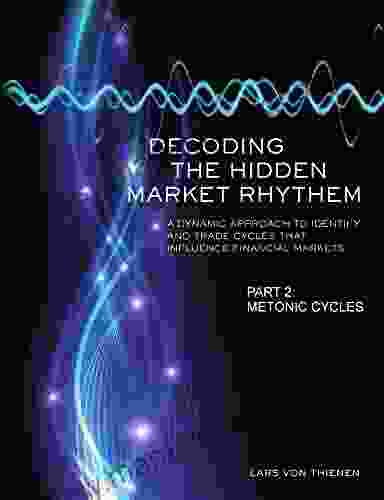Non-Linear Approach to Identifying and Trading Cycles That Influence Financial Markets

Financial markets are characterized by cycles that can significantly impact investment decisions. While traditional approaches to market analysis often focus on linear trends, a non-linear approach can provide a more accurate understanding of market dynamics and help traders identify trading opportunities. This article explores the non-linear nature of financial markets, presents techniques for identifying cycles, and discusses strategies for profiting from them.
5 out of 5
| Language | : | English |
| File size | : | 16356 KB |
| Text-to-Speech | : | Enabled |
| Screen Reader | : | Supported |
| Enhanced typesetting | : | Enabled |
| Word Wise | : | Enabled |
| Print length | : | 239 pages |
Non-Linearity in Financial Markets
Financial markets exhibit non-linear behavior, meaning that the relationship between price and time is not constant. Instead, prices tend to move in cycles, with periods of expansion followed by periods of contraction. These cycles can range from short-term fluctuations to long-term macroeconomic trends.
There are several reasons why financial markets are non-linear:
* Market Psychology: Fear, greed, and speculation can lead to herd behavior, causing markets to overshoot equilibrium levels. * External Events: Unexpected events, such as economic shocks, political turmoil, or natural disasters, can disrupt market trends. * Technological Advancements: Technological innovations can create new products or services, disrupting existing industries and driving market cycles.
Identifying Trading Cycles
To identify cycles in financial markets, traders can employ various technical analysis techniques:
* Moving Averages: Moving averages help smooth price data, revealing underlying trends and cycles. Traders can use different time frames to identify cycles of varying durations. * Bollinger Bands: Bollinger Bands measure price volatility and can help identify cycle peaks and troughs. Prices tending to move within the bands' boundaries suggest a cycle, while breakouts indicate a potential trend change. * Elliott Wave Theory: Elliott Wave Theory posits that markets move in a series of predictable waves. Traders can use this theory to identify cycle tops and bottoms. * Fibonacci Retracements: Fibonacci Retracements are based on historical price movements and can help traders identify support and resistance levels that indicate potential cycle turning points.
Trading Strategies Based on Cycle Identification
Once cycles have been identified, traders can develop strategies to profit from them:
* Trend Following: Trend following strategies aim to identify the direction of the prevailing cycle and trade in accordance with it. Traders look for confirmation of trends through multiple indicators and enter positions in the direction of the trend. * Counter-Trend Trading: Counter-trend trading involves taking trades against the current cycle. This strategy is suitable for experienced traders who can identify potential reversals. * Cycle Reversal Trading: Cycle reversal trading involves identifying turning points in cycles and entering positions accordingly. Traders look for divergence between price and indicators or volume patterns to anticipate cycle changes. * Trading Channel Breakouts: Channels are formed by parallel lines connecting highs and lows. Breakouts from channels can signal the start of a new cycle, providing trading opportunities.
Applying Non-Linear Analysis to Real-World Markets
Let's illustrate the application of non-linear analysis to identify and trade cycles in the S&P 500 index:
* Moving Averages: A 200-day moving average can help identify long-term market trends. Periods of extended deviation from the moving average often indicate potential cycle turning points. * Bollinger Bands: Bollinger Bands can identify periods of low volatility, which often precede trend changes. Breakouts from the Bollinger Bands can signal the start of a new cycle. * Elliott Wave Theory: Elliott Wave Theory suggests that the S&P 500 is currently in Wave 5 of an impulsive bull cycle. This wave is characterized by a rapid advance, followed by a correction. * Fibonacci Retracements: Fibonacci Retracements can help identify support and resistance levels that coincide with potential cycle highs and lows.
Adopting a non-linear approach to market analysis provides traders with a deeper understanding of financial market dynamics and cycles. By identifying cycles and utilizing trading strategies tailored to them, traders can enhance their trading performance and navigate the complexities of financial markets. However, it's crucial to note that financial markets are complex systems, and no approach can guarantee success. Risk management, discipline, and continuous learning are essential elements of successful trading.
5 out of 5
| Language | : | English |
| File size | : | 16356 KB |
| Text-to-Speech | : | Enabled |
| Screen Reader | : | Supported |
| Enhanced typesetting | : | Enabled |
| Word Wise | : | Enabled |
| Print length | : | 239 pages |
Do you want to contribute by writing guest posts on this blog?
Please contact us and send us a resume of previous articles that you have written.
 Top Book
Top Book Novel
Novel Fiction
Fiction Nonfiction
Nonfiction Literature
Literature Paperback
Paperback Hardcover
Hardcover E-book
E-book Audiobook
Audiobook Bestseller
Bestseller Classic
Classic Mystery
Mystery Thriller
Thriller Romance
Romance Fantasy
Fantasy Science Fiction
Science Fiction Biography
Biography Memoir
Memoir Autobiography
Autobiography Poetry
Poetry Drama
Drama Historical Fiction
Historical Fiction Self-help
Self-help Young Adult
Young Adult Childrens Books
Childrens Books Graphic Novel
Graphic Novel Anthology
Anthology Series
Series Encyclopedia
Encyclopedia Reference
Reference Guidebook
Guidebook Textbook
Textbook Workbook
Workbook Journal
Journal Diary
Diary Manuscript
Manuscript Folio
Folio Pulp Fiction
Pulp Fiction Short Stories
Short Stories Fairy Tales
Fairy Tales Fables
Fables Mythology
Mythology Philosophy
Philosophy Religion
Religion Spirituality
Spirituality Essays
Essays Critique
Critique Commentary
Commentary Glossary
Glossary Bibliography
Bibliography Index
Index Table of Contents
Table of Contents Preface
Preface Introduction
Introduction Foreword
Foreword Afterword
Afterword Appendices
Appendices Annotations
Annotations Footnotes
Footnotes Epilogue
Epilogue Prologue
Prologue Swan Aung
Swan Aung Mark Condon
Mark Condon Kevin Coval
Kevin Coval Luke Levi
Luke Levi Kathy Schwalbe
Kathy Schwalbe Ann Betz
Ann Betz Lars Von Thienen
Lars Von Thienen Leona Deakin
Leona Deakin Rachel Mitchell
Rachel Mitchell Marco May
Marco May Judy Foreman
Judy Foreman Dikla Levy Frances
Dikla Levy Frances Kathy Reichs
Kathy Reichs Bernard A Weisberger
Bernard A Weisberger Evelyn S Johnson
Evelyn S Johnson Hanoch Levin
Hanoch Levin Rachel Oates
Rachel Oates Katherine Hall Page
Katherine Hall Page J A Jance
J A Jance Anita Loos
Anita Loos
Light bulbAdvertise smarter! Our strategic ad space ensures maximum exposure. Reserve your spot today!

 Heath PowellMirror of Misery: A Haunting Tale of Redemption and the Dark Side of Human...
Heath PowellMirror of Misery: A Haunting Tale of Redemption and the Dark Side of Human...
 Douglas AdamsThe Unknown James Nash: A Journey into the Life and Legacy of a Forgotten...
Douglas AdamsThe Unknown James Nash: A Journey into the Life and Legacy of a Forgotten... Nikolai GogolFollow ·16.9k
Nikolai GogolFollow ·16.9k Henry JamesFollow ·16.7k
Henry JamesFollow ·16.7k John MiltonFollow ·6.9k
John MiltonFollow ·6.9k Ryan FosterFollow ·9.2k
Ryan FosterFollow ·9.2k Brent FosterFollow ·18.6k
Brent FosterFollow ·18.6k Ivan CoxFollow ·7.8k
Ivan CoxFollow ·7.8k Billy FosterFollow ·9k
Billy FosterFollow ·9k Roland HayesFollow ·6.6k
Roland HayesFollow ·6.6k

 Roland Hayes
Roland HayesFive Unique Eating Plans to Shatter Your Weight Loss...
Weight loss journeys can be a rollercoaster...

 Gustavo Cox
Gustavo CoxThe Small Habits Revolution: How Tiny Changes Can...
Are you ready to...

 Herman Mitchell
Herman MitchellVisit Alook Cool Place In Outer Space Let Explore The...
Welcome to the World Series...

 Hassan Cox
Hassan CoxGaunt's Ghosts Omnibus: A Comprehensive Guide to the Epic...
Prepare to embark on an...
5 out of 5
| Language | : | English |
| File size | : | 16356 KB |
| Text-to-Speech | : | Enabled |
| Screen Reader | : | Supported |
| Enhanced typesetting | : | Enabled |
| Word Wise | : | Enabled |
| Print length | : | 239 pages |












